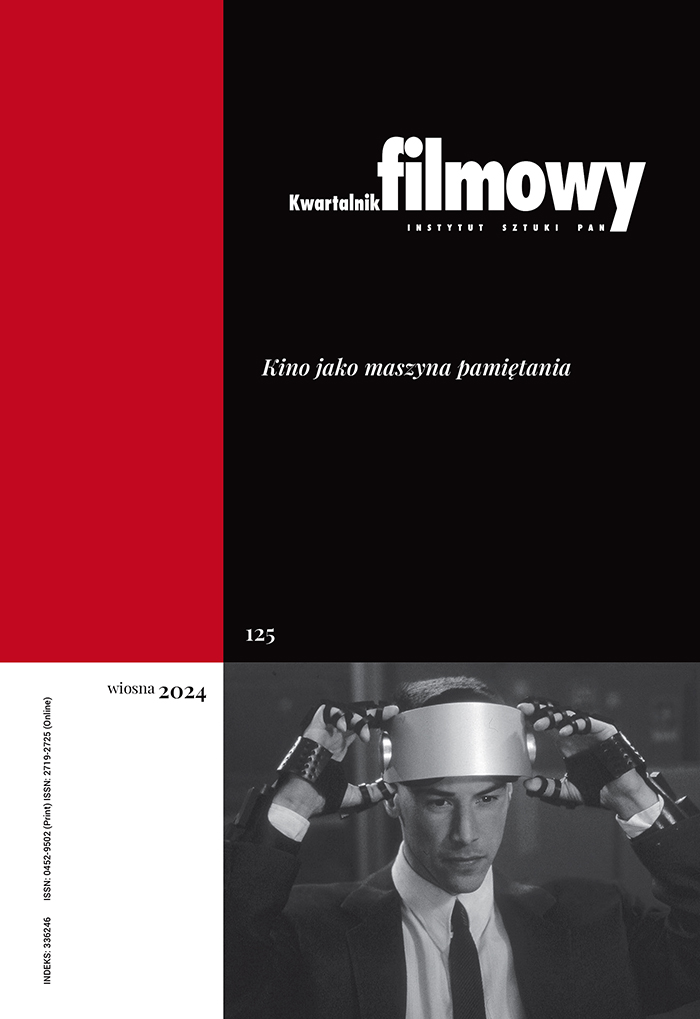“Nothing Is Missing”: Video Heteroglossias
Agnieszka Rejniak-Majewska
kwartalnik.filmowy@ispan.plUniversity of Lodz (Poland)
Tomasz Majewski
University of Lodz (Poland)
Abstract
The article deals with large screen installation Nothing is missing by the Dutch theoretician Mieke Bal. The installation consists of a cycle of videos of immigrant mothers from Africa, Asia and Eastern Europe. The videos problematize the issue of the experience of cultural alienation/otherness. The positions of “exoticism” and “intimacy” of family meetings are mediated and then abolished - they are shown to be falsely assumed opposites of the expected. The authors consider this installation in the phenomenological and aesthetic dimensions, and in the context of Mieke Bal’s theoretical assertions dealing with the issue of ethnic representations and post-structuralist narratology with its issue of the “embodied voice”. They point to the source of inspiration for the video series, that is the writings of Mikhail Bakhtin and Kaja Silverman and the categories of heteroglossia and heteropathic identification created in order to describe the situation of meeting with the Other.
Keywords:
Mieke Bal, video art, Mikhail Bakhtin, Kaja SilvermanReferences
Aviram, Amittai. 1994. Telling Rhythm: Body and Meaning in Poetry. Ann Arbor, Michigan.
DOI: https://doi.org/10.3998/mpub.14048
Google Scholar
Bal, Mieke. 1991. Reading Rembrandt. Beyond the Word-Image Opposition. Cambridge: Cambridge University Press.
Google Scholar
Bal, Mieke. 1997. Looking at Love: An Ethics of Vision. „Diacritics” t. 27, nr 1.
DOI: https://doi.org/10.1353/dia.1997.0002
Google Scholar
Bal, Mieke. 2007. A Thousand and One Voices. „Amsterdam International Electronic Journal for Cultural Narratology” 2007, nr 4, http://cf.hum.uva.nl/narratology/a07_bal.htm
Google Scholar
Bal, Mieke. 2007. Lost in Space, Lost in Library. W: S. Durrant, C. M. Lord (red.). Essays in Migratory Aesthetics: Cultural Practices Between Migration and Art-making. Amsterdam – New York: Editions Rodopi B. V.
DOI: https://doi.org/10.1163/9789401204675_003
Google Scholar
Bogusławska, Karolina, Ola Jach, Ewa Łączyńska. 2009. Jestem feministką totalną. Dla mnie to rzecz naturalna (rozmowa z Mieke Bal). http://www.obieg.pl/rozmowy/5716.
Google Scholar
Fried, Michael. 1967, 1998. Art and Objecthood (1967), W: tegoż, Art and Objecthood. Essays and Reviews. Chicago-London: University of Chicago Press.
Google Scholar
Authors
Agnieszka Rejniak-Majewskakwartalnik.filmowy@ispan.pl
University of Lodz Poland
Historyk sztuki i estetyk, adiunkt w Instytucie Filozofii Uniwersytetu Łódzkiego; zajmuje się problematyką sztuki nowoczesnej i krytyki sztuki, w szczególności historią angloamerykańskiego formalizmu. Autorka przekładów prac Martina Jaya, Rosalind Krauss, Anne Friedberg, Andreasa Huyssena.
Authors
Tomasz MajewskiUniversity of Lodz Poland
Kulturoznawca i filmoznawca, wykłada w Instytucie Kultury Współczesnej Uniwersytetu Łódzkiego. Zajmuje się teorią kultury popularnej, badaniami nad kulturą wizualną i reprezentacjami Holocaustu. Redaktor tomów Rekonfiguracje modernizmu. Nowoczesność i kultura popularna (2009), Pamięć Shoah. Kulturowe reprezentacje i praktyki upamiętnienia (II wyd. 2011). Autor książki Dialektyczne feerie. Szkoła frankfurcka i kultura popularna (2011).
Statistics
Abstract views: 192PDF downloads: 91
License
Copyright (c) 2012 Agnieszka Rejniak-Majewska, Tomasz Majewski

This work is licensed under a Creative Commons Attribution 4.0 International License.
The author grants the publisher a royalty-free non-exclusive licence (CC BY 4.0) to use the article in Kwartalnik Filmowy, retains full copyright, and agrees to identify the work as first having been published in Kwartalnik Filmowy should it be published or used again (download licence agreement). The journal is published under the CC BY 4.0 licence. By submitting an article, the author agrees to make it available under this licence.
In issues from 105-106 (2019) to 119 (2022) all articles were published under the CC BY-NC-ND 4.0 licence. During this period the authors granted a royalty-free non-exclusive licence (CC BY-ND 4.0) to use their article in „Kwartalnik Filmowy”, retained full copyright, and agreed to identify the work as first having been published in our journal should it be published or used again.
Most read articles by the same author(s)
- Tomasz Majewski, Setting Eyes on the Gorgon: Siegfried Kracauer and Film Theory After Holocaust , Kwartalnik Filmowy: No. 67-68 (2009): Film History
- Tomasz Majewski, Lycopodium – From Pyrotechnics to Xerography: Toward a (Bio)Archeology of Media , Kwartalnik Filmowy: No. 99 (2017): Tricks, Special Numbers, Attractions











